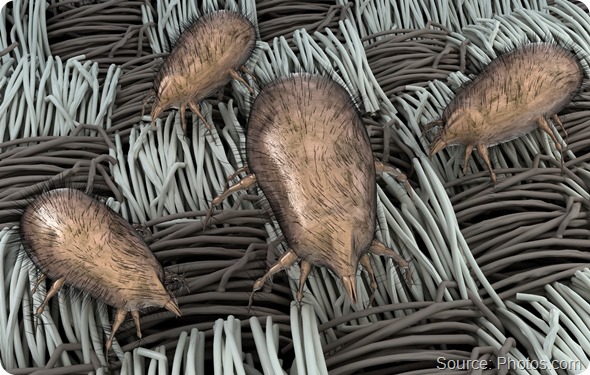House dust mite allergy is a surprisingly prevalent problem. Something like 27% of the U.S. population and 20% of the European population are what’s called skin-prick test positive for house dust mites, which is a test for sensitivity to allergens to find out if a person is likely to get that allergy.
The test involves putting the actual allergen itself on the skin and pricking the skin to see if there’s a reaction. A huge number of people are skin-prick test positive to house dust allergens. That doesn’t necessarily mean to say they’ve all got symptoms; approximately half have got clinical symptoms.
However, that’s a huge percentage of the population, and probably half to two thirds of those with clinical symptoms have got moderate-to-severe allergy. These are really bothersome symptoms that affect people’s ability to work and function.
Most people will have friends that are allergic to house dust mites - whether they know it or not - where they get up in the morning, they’re all bunged up, sneezing with itchy, watery eyes. With house dust mite allergy, it is similar to having a really heavy cold almost permanently, because the problem is there all the time and the mites are everywhere, all over the house. There is not much that can be done to eradicate the problem. You can reduce the burden of house dust mites by removing the carpets and keeping everything clean, but that is not enough to actually eradicate it or materially reduce symptoms.
House dust mite allergy is a major healthcare problem and it really impacts the way people can function both at home and at work. It’s a very important issue, a worldwide issue, and is an allergy that is prevalent across the globe.

What treatments are currently used to reduce patients’ symptoms of house dust mite allergy? How successful are these?
With all allergies, the first line of treatment is to use antihistamines and then nasal steroids. However, various patient reports show that something like two-thirds of patients are not satisfied with current treatments.
Some of them, or certainly those with milder symptoms are probably satisfied, but these treatments actually only target symptoms which is a really important point. These treatments have to be taken on an ongoing basis; both the antihistamines and nasal steroids have to be taken every day.
What we are trying to do is to treat the underlying cause of the disease, so that this ongoing treatment is not needed. The only treatment currently available that does this is what’s called whole allergen immunotherapy, which involves administering very small and increasing doses of the very allergen a patient is allergic to.
Treatment programs vary depending on the market. Americans give these injections up to 2 or 3 times a week for up to 6 months and then move onto bi-weekly and then monthly injections for 3 to 5 years. In Europe, the regimen doesn’t tend to be quite so aggressive - they might administer the injections weekly or bi-weekly and then monthly, but again for 3 to 5 years.
So you can understand the frustration of being allergic and the only way to treat the underlying cause of the disease is to have 3 to 5 years of treatment, and the treatment is unpleasant because it has side effects.
Giving a patient the very allergen they’re allergic to can have some serious side effects. These products are not generally approved in Europe. The efficacy data is mixed and the safety data is poor and they’re considered non-mainstream pharmaceuticals. They haven’t all gone through phase 3 studies; they’ve been ‘grandfathered’ in over a hundred years, which is how long ago this approach started.
Please can you give an introduction to the new treatment Circassia is developing for house dust mite allergy?
We’ve taken a completely novel approach using what’s called T cell epitopes. We look at the actual house dust mite allergens, and take very short sequences of those allergens. These are the T cell epitopes that bind to antigen presenting cells and generate regulatory T-cells that down regulate the allergic symptoms on an ongoing basis.
The fantastic thing for patients about our treatment is that we give all injections using a micro injector so that it’s a pain-free, patient-friendly injection. Also, we only give four injections, spaced four weeks apart rather than treatment that lasts years.
In terms of results, what we have found with our house dust mite treatment is that one year later, the patient symptoms have dramatically dropped. This is consistent with our previous study into cat allergy where exactly the same thing happened. Of course, in the cat allergy study, it’s a different product, because this is an allergen-specific approach, so a house dust mite product is specifically for dust mites and a cat product is specifically for cats, but it’s exciting that we’re seeing consistency across our platform: four injections given four weeks apart has significant efficacy one year later and nobody’s ever seen data like that before.
You have recently announced the results from a phase II clinical study of your house dust mite allergy treatment. What was the study’s primary endpoint and how successful was the trial overall?
The primary endpoint was what’s called a change in the total rhino conjunctivitis symptom score and that’s a measure of nasal, ocular and other symptoms. We measured the patients’ symptoms at baseline before they’d had any treatment and then randomized them to either our treatment or placebo on a double blind basis. Then we evaluated them again at one year and compared the symptom scores to those when they started the study.
What we saw that was of major importance was that there was a statistically significant benefit over placebo, as it was dramatically better than placebo a year later.
In all clinical studies, you get is a placebo effect. The people on placebo actually feel some improvement and that’s very common in allergy studies because these are self-reported outcomes and you ask the patient to score how they feel. Even in oncology studies, you can see some placebo effects because the attention from doctors and nurses can make patients feel better to some extent.
So, our job is to make patients feel not only better than how they felt at the start, but to feel statistically significantly better than the placebo group felt, and that’s exactly what we achieved. It was a very dramatic treatment effect: at one year an improvement not only over baseline but over the placebo group. It was a very encouraging result.
How well tolerated is the treatment?
The safety data not just in house dust mite allergy, but across our platform has been really outstanding. You get a mild erythema at the site of the injection which is similar to the placebo.
If you look across the database, you have to consider that these people have been studied for a whole year, and you have to capture all of the headaches, cough, colds, etc. that they have over the course of that study. Yet, there’s no difference between the active group and the placebo group. One of our strongest benefits is our positive safety profile.
What further research is needed to bring the treatment to market?
The next major step is the final part of the testing which will be a large Phase 3 study. In addition, there are a couple of other supporting studies that we need to do. We’ll perform an asthma safety study, which is what we did with our cat program to demonstrate that it’s safe in asthmatics.
There’s a very close link between allergy and asthma and in particular between cat allergy and house dust mite allergy and asthma. The general belief is that if you treat the allergy, it does not progress to asthma. Therefore, we’d very much like to include those patients in our phase III clinical study.
What excites you most about Circassia’s current technologies?
We get much better efficacy than the competition and we have a much better safety profile. A treatment regime that only involves four administrations is much better than anything else that anybody’s ever achieved and patients gain a long term benefit. That has never been seen before. We’ve now seen it across multiple programs, which I think reinforces the strength of the technology.
What are Circassia’s plans for the future?
To drive our programs to the market.
Where can readers find more information?
About Steve Harris
 Steve Harris is a successful bioscience entrepreneur with extensive experience of founding and leading specialty pharmaceutical companies.
Steve Harris is a successful bioscience entrepreneur with extensive experience of founding and leading specialty pharmaceutical companies.
Prior to establishing Circassia, he was a founding member of the management team that grew Zeneus into a leading specialty pharma company following the acquisition of Elan’s European business for $110m.
As CFO and subsequently as CEO, he played a key role in refocusing the business, turning around under-performing products and managing the company’s acquisition by Cephalon for $390m in 2006.
Prior to Zeneus, he spent seven years at PowderJect Pharmaceuticals Plc as CFO, where he was a key member of the management team that grew the private biotechnology organisation into an integrated, profitable public company, which became the world’s fifth largest vaccines business before being acquired by Chiron (now Novartis) for $1 billion in 2003.